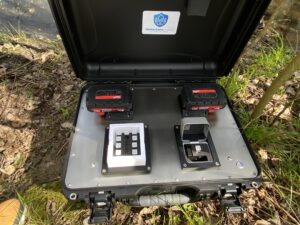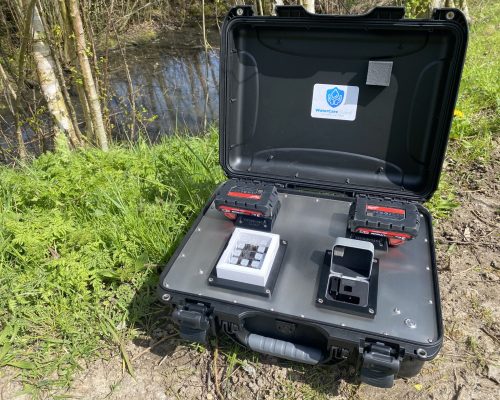Products' Profile
The biotech systems we build here at WaterCare Guard revolve around the concept of allowing our customers to perform laboratory-grade spectroscopy measurements directly in the field, in real time.
Thus, we employ an IoT-specific architecture, with hardware and software components interconnected via mobile network.


There are no other portable solutions, at present, able to detect the concentration of Volatile Organic Compounds in bodies of water.
Our flagship product does exactly that!
With the solution we have developed so far, we’ve won the I-prisen local entrepreneurship prize in Sønderborg in December 2022.
In September 2021, we have received together with our partners 700,000 DKK in funding from the Industri 4.0: DigitaliseringsBoost innovation programme which is supported by Danmarks Erhvervsfremmebestyrelse and the European Regional Development Fund.
The mobile unit
Briefly...
The Vand og Jord department at Region Syddanmark, needed a solution for detecting underground water contamination with chemicals in the Volatile Organic Compounds group.
They became our lead customer, and our answer came in the form of a Minimum Viable Product comprised of a portable unit which can detect and quantify Vinyl Chloride concentration as low as 20 µg/l in in real-time and display it in a web application.


The problem...
Industrial activity in Denmark over the last 120 years has caused, as a side-effect, major water pollutants from the Volatile Organic Compounds group to be present in groundwater. Among these, Vinyl Chloride is one of the most toxic and carcinogenic compounds, and it occurs in the environment from the production of chlorinated solvents, after a degradation process.
The creation and management of water quality systems which can detect and monitor these compounds have always posed numerous challenges due to the high volatility of these chemicals, particularly that of Vinyl Chloride.
The solution...
By collaborating with University of Southern Denmark and Copenhagen Nanosystems, a new method was designed, focusing on:
“a change in the sample refractive index by inducing an enzymatic reaction selective to Vinyl Chloride. The changes in refractive index are monitored via guided-mode resonance by using a grated TiO2 surface acting as a photonic crystal.”
– “Chemical aquatic pollution monitoring with portable agile methods: a demonstration of vinyl chloride detection in environmental waters”
Authors: Roana de Oliveira Hansen, Sabita Acharya, Gabriel Ioan-Dudas, Sangita Khatri, Arpita De, Emil Højlund-Nielsen and Jacek Fiutowski


<span data-metadata=""><span data-buffer="">Results in
5 and 15 – 40 minutes
The resulting biosensor, called the Mobile Unit, is a complete sensor system exhibiting sensitivity, selectivity, accuracy and precision characteristics, and is incorporated at the same time into a larger software solution.
It can perform measurements for Vinyl Chloride concentration detection in the span of 15-40 minutes, as well as both classic absorbance spectroscopy and label-free spectroscopy measurements via refractive index within 5 minutes.
550 - 800
nm
Sensitivity is assured by applying NanoCuvettes One™, where a grated TiO2 photonic crystal acts as an optical filter when light passes through it. This upgrade in analytical capability provides results over a wavelength range going from 550 nm to 800 nm.
By using predicted resonance related to guided mode, which is very sensitive to the surface condition and refractive index of other medium, changes in the range of 10-5 in refractive index can be recognized due to peak shift.
<span data-metadata=""><span data-buffer="">Enzymatic reaction
selectivity
Upon exposure to many different chemicals in groundwater samples, the sensor needs to respond only to Vinyl Chloride. This selectivity is obtained by adding a binder like cytochrome P450 2E1 human enzyme to the samples.
The ensuing enzymatic reaction significantly increases the sample’s refractive index over a time span ranging from 15 to 40 minutes and is directly related to the Vinyl Chloride concentration.
Partners & Suppliers
Lead CUSTomers
Technical Specification
General
- Primary use: detection of Vinyl Chloride concentration
- Limit of Detection: 20 ug/l
- Secondary use: Sample analysis based on UV-Vis spectrophotometry
- IP67 standard – waterproof and dustproof when closed
- Size: (L x W x H): 503 x 406 x 193 mm
- Weight: 10kg with batteries. 8,9kg without batteries
Hardware
- Spectrometer:
- Optimized for UV-Vis
- Wavelength Range: 200-850 nm
- Typical Optical Resolution (FWHM): 1.33 nm
- Enhanced sensitivity
- Toshiba CCD array detectors
- Built-in LTE network for connectivity
- Custom built holder for an individual cuvette or NanoCuvette™ with connected servomotor allowing for automatic °90 rotation
- Cuvette box holder for cuvettes or NanoCuvettes™
- Cuvette holder specification:
- Collimating Lenses: Two 74-UV fused silica lenses (200-2000 nm)
- Filter Slot: One slot accepts one 12,5 mm and 25 mm diameter filters and apertures
- Pathlength: 1 cm
- Z Dimension: 15 mm
- 2 x 3,0Ah Lithium batteries – Milwaukee
Complementary equipment
- Cytochrome P450 2E1 human enzyme for selectivity towards Vinyl Chloride
- Micropipette
Software
- Web application – data visualization, hardware control, online/offline capabilities
- Spectroworks™ – backup platform for data visualization
Team and collaborators

Jonas Hoff
Barnkob
Founder & CEO

Jan Tiettje
Mechanical Prototyping & Production

Lucian Alex
Coseru

Jacek Fiutowski,
PhD

Roana de Oliveira
Hansen, PhD
R&D Functional Materials
- Students from University of Southern Denmark -
Mobile Unit v. 3
Cuvette rotation mechanism
- Davi Gonçalves Accioli
- Emerson Miguel Lima Woo
- Mohamed Amine Betira
- Sharva Yatin Nemane
- Yousef Shekh-Kilo
- Mustafa Abdullah Abdulhay
- Ahmed Mahmoud
- Samson Adem Kisho
- Aly Ahmed Allam
- Devansh Rajesh Chawda
- Asif Ahmed
- Jacob Thomas Puthukeril
- Moudji Ferdinand Ndille
Mobile Unit v. 2
Sabita Acharya
– Laboratory analysis
Mobile Unit v. 1
Arthur Blaser
– Suitcase design
Gabriel-Ioan Dudas
– Laboratory analysis
